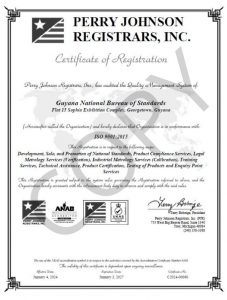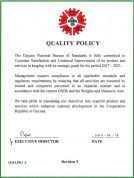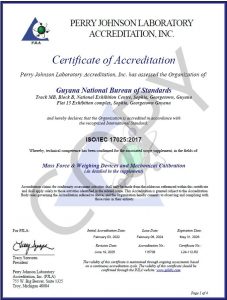Guyana’s expanding economy, driven by investments in sectors like oil and gas, housing and agriculture has created a surge in demand for infrastructure development. To guarantee long-lasting structures, the use of standards in the construction sector is crucial. At this weekend’s International Building Expo, manufacturers are showcasing a wide range of new and traditional materials. Also, an exhibitor at the event is the Guyana National Bureau of Standards (GNBS), seeking to promote the use of National, Regional and International Standards which are related to the products and services used in the industry.
To promote resilient and quality buildings, bridges and other structures, the GNBS has twenty-one (21) related construction standards. One of the most paramount concerns addressed by these standards is the safety, durability and resilience of structures against hazards such as floods, vibrations and more. As such, it is imperative to adopt and implement standards, as they play a pivotal role in upholding the quality and longevity of buildings.
Among the list of construction standards is the GYS 168 – “Bases for design of structures – Serviceability of buildings against vibration”, adopted from the International Standard, ISO 10137 – Bases for Design of Structures. It applies to buildings, pedestrian bridges and walkways found within buildings or connecting them and does not include bridges that carry vehicular traffic, nor the design of foundations or supporting structures of machinery.
Understanding the significance of the GYS 168 Standard, for example, is critical for engineers, architects, and stakeholders alike. This standard gives recommendations on the serviceability of buildings against vibrations to effectively mitigate discomfort and potential long-term damage. It covers three recipients of vibrations: human occupancy in buildings and on pedestrian bridges; the contents of the building; and the structure of the building.
This standard recognizes that vibrations can resonate from various sources including human activity and occupancy, machinery, construction and traffic. As such, the aim of this standard is to ensure that structures remain functional and safe under the influence of these and other hazards.
Standards such as this, are recognized for their rigorous development processes and adherence to best practices. Moreover, adherence to this standard and the use of materials enhances a project’s credibility, as it demonstrates a commitment to safety. workmanship and maintenance, ensuring that structures are built to withstand the test of time.
It is important for contractors and engineers to adhere to these construction guidelines as many buildings are being erected either from the ground floor or upwards. If unable to withstand a relatively mild natural phenomenon such as a tremor or storm, the potential for injuries or deaths due to damage is greater.
Given the risks associated with structures that are not built to the required specifications, the GNBS urges contractors, engineers, and homeowners to use National, Regional and International Standards. To learn more about the available standards, services and programmes of the GNBS, contact the GNBS by telephone numbers: 219-0064-66 or WhatsApp 692-4627. You can also visit our website:www.gnbsgy.org and our Facebook page: gnbsgy.






